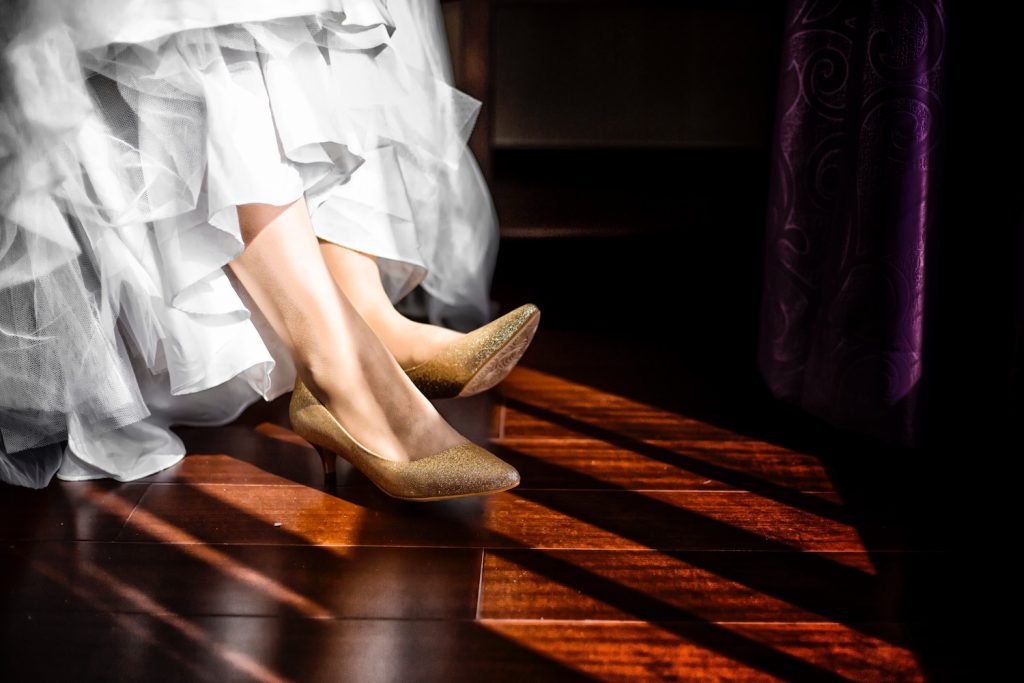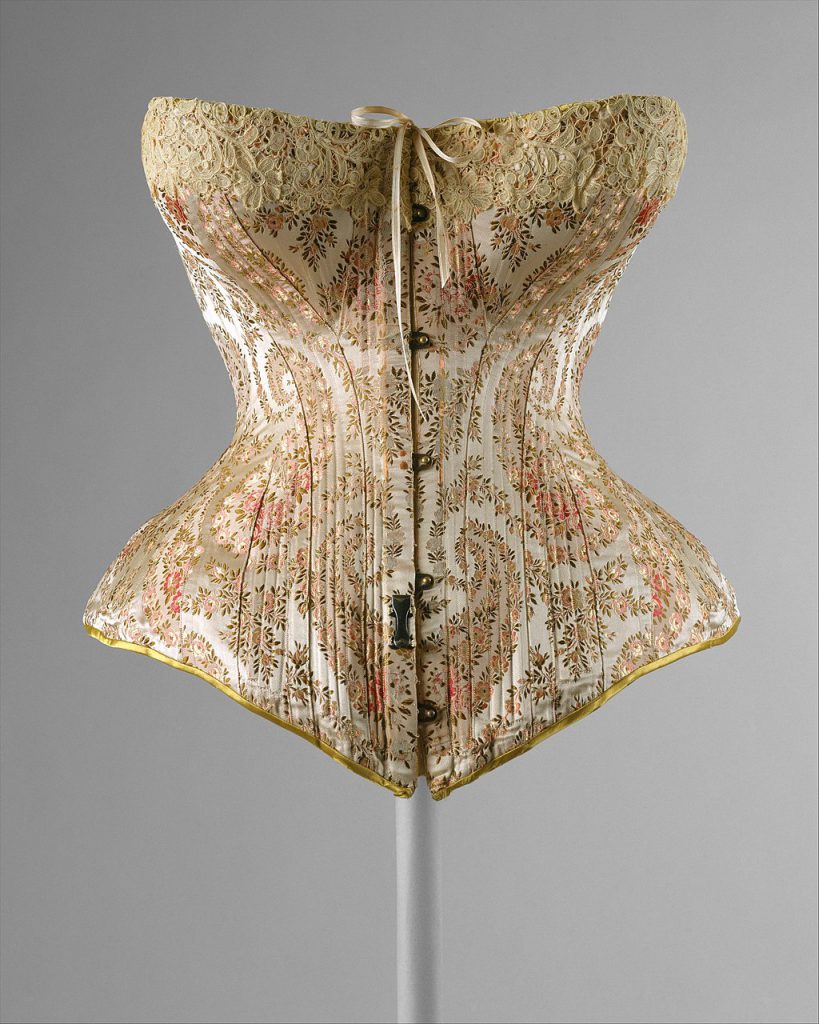Structural Violence and Human Biology
by Anna Brachey
Structural violence, the creation of differential opportunities and health outcomes due to disparities in access, leaves behind tell-tale signs on the highly plastic human skeleton. This paper explores the history and health impacts of corsetry in Victorian Europe through the lens of the social sciences, conceptualizing the phenomenon as an example of structural violence against women. Women who wore corsets suffered substantially decreased mobility and experienced short- and long-term health issues. Beyond that, they were culturally defined by the values attached to the corset, losing some freedom of identity. Just like other forms of structural violence, corsetry leaves behind indicators on the skeleton in the bioarchaeological record, which are described in this paper. This paper explores instances of corsetry and contextualizes them with examples of other acts of structural violence against women, including foot-binding, differential nutrition, and the medicalization of child birth. In order to contextualize corsetry in the frame of historical structural violence against women, a number of other examples of gender-based structural violence and their bioarchaeological indicators are outlined, including foot-binding, differential nutrition, and the medicalization of childbirth. Overall, the example of Victorian corsetry as structural violence illustrates the relationship between human biology and culture, as societal tension and discrimination create differential access and negative, biologically significant, impacts on oppressed groups.
Social and biological sciences are often kept separate in the academic and professional worlds, but these divisions between disciplines do not represent reality as human beings live it. In reality, the social structures and practices that we invent around ourselves and one another form our daily habits and practices, and these practices form our biological realities—the factors of health, stress, and pathology which can be examined in human remains in the bioarchaeological record. Large social structures and overarching patterns of social relations can directly impact the anatomy and physiology of a human being. The social science perspective of bioarchaeology, as defined by Stojanowski and Duncan (2015), aims to view bioarchaeological evidence in relation to large-scale patterns of human migration, social relations, and tradition and culture. This unique perspective can clarify the understanding of the impact of the social customs and systems on physiological health. In particular, social and cultural forces acting through stable, integrated systems of structural violence have historically caused health issues and suffering in marginalized groups, especially in females. Victorian corsetry is a prime example of a social structure inventing a cultural tradition to impose power and maintain a dichotomy of access and opportunity through the biological modification of the female body.
In bioarchaeology, violence is easily detected. Often, blunt force trauma and fractures are obvious and well-studied in human remains. But violence should not be defined so narrowly as to only include those manifest violences of combat. Often the more influential structural violences are those that may appear to be subtle in the bioarchaeological record. In his “Violence, Peace, Peace Research,” Johan Galtung proposes a definition of violence “as the cause of the difference between the potential and the actual, between what could have been and what is” (1969, pg. 168). This broader understanding of violence encompasses harmful systems that can impact individuals as significantly as interpersonal violence. Galtung goes on to define and discuss a classification of violence which will be the focus of this paper: structural violence. Structural violence is a form of violence which is built into a system, for example, a structure of political, social, or economic power. One distinguishing factor of structural violence is that no particular perpetrator must act the violence, and no victim necessarily has to experience obvious injury (a wound or fracture, for example). Instead, Galtung explains that the violence manifests itself “as unequal power and consequently unequal life chances” (1969, pg. 171). The idea of structural violence gives significance and terminology to the unequal health outcomes that have historically been experienced by marginalized groups and have been significantly less studied because of a lack of obvious physical trauma.
Structural violence is much less obvious than manifest violence in the bioarchaeological record, but it does leave behind traces on the skeleton which can be understood in light of historical and social contexts. General insults to growth caused by a variety of stress-factors, specific infection, and particular dietary deficiencies all leave characteristic and long-lasting markers on the teeth and bones. For example, diet deficiencies like vitamin C and D deficiency and iron-deficiency anemia each cause the formation of tell-tale lesions or deformities on the skull and bones. Some specific diseases also leave behind particular markers. Tuberculosis, for example, can infect the bones and cause observable damage and deformity. Even without evidence of dietary deficiencies or specific diseases, the presence of intense physiological stress can be observed in the form of Linear Enamel Hypoplasia (LEH) in the teeth and Harris Lines in the long bones. These marks on the teeth and bones are evidence of metabolic stress during development which could have been caused by infection, trauma, or malnourishment (Manchester and Roberts, 2007). All of these skeletal and dental markers can help bioarchaeologists determine the comparative health of social groups, contributing to an understanding of power structures in past societies.
Structural violence exemplifies the ways that a combination of social structure and cultural tradition can shape human biology. It is a significant example of an individual’s social experience altering biological health that can help create a more holistic and realistic bioarchaeology; Haagen D. Klaus even argues that the study of structural violence has the potential to “bridge the science/culture divide in anthropology” and “promote balanced integration of empirical studies of ancient skeletons and social theories used to interpret skeletal data” (2012, pg. 34). Biological evidence shows us that throughout time and across societies, social factors have had dangerous potential to become biological traits through stable and systematic structural violence. Marginalized groups are by definition more severely impacted by structural violence as they suffer from disparity of economic resources, oppressive social systems, and poor access to health resources and clean conditions. By studying the skeletal remains for evidence of structural violence, the gap between science and culture is bridged, and anthropologists can give a voice and story to oppressed victims of the subtle violences of history.
Female health and biology have in particular been disproportionately impacted by structural violence through hegemonic maltreatment and oppression, differential healthcare, and even physical impediment of movement through body modifications and fashions that are inherently unproductive and harmful to the body. These violences have historically burdened women with physiological stress and decreased mobility, power, and opportunity. Corsetry in Victorian England is a particularly interesting example of an act of structural violence. It is the active propagation of cultural body modifications that decreases female mobility and imposes a cultural ideal upon a woman.
Victorian England generally associated femininity with “frivolity, delicacy, inactivity, and submissiveness,” and this perception was reflected in the clothing of the era: layers of hooped skirts or cages, low and tight sleeves, and corsets (Roberts, 1977, pg. 557). Historically, corseting had the potential to decrease the waist to an approximately thirteen-inch circumference, to apply extreme pressure to the torso, and to decrease lung capacity significantly (Schnable 1986). Wearing a tight-laced corset can cause many health issues while worn including “shortness of breath . . . obstructed bowels, incontinence, and prolapsed uterus” (Stone, 2012, pg. 57). Not only did corsetry cause extreme issues with the normal function of internal organs in women, but it also impacted their ability to be mobile and active on a day to day basis. In their writings, Victorian women pointed to a feeling of constant fatigue and weakness when wearing the corset, which decreased activity and mobility (Roberts 1977). These considerable discomforts and handicaps associated with corseting can be viewed as an obstruction of female activity and autonomy, creating a frailer female to match the cultural ideal of the era.
The effects of corset-wearing are not only temporary discomforts. Few studies have focused on the long-term evidence of corset-wearing in the bioarchaeological record, but those that have support the hypothesis that corset-wearing alters the plastic skeleton, forming an irregular female skeletal structure visible in human remains. Gibson’s study was particularly interesting and thorough as she investigated evidence of corsetry on Victorian skeletal remains alongside corsets from the period and textual evidence about how women felt about wearing their corsets. Gibson found that the twelve female skeletons in her case study exhibited deformations in the ribs and spinal processes that indicated lifelong physical deformity from corsetry (2001). Corsets can be viewed (perhaps not universally, but at least in many cultural contexts) as a female attempt to fit the cultural expectation of a small and frail woman, particularly one whose social status allows her to avoid physical labor. While corsets minimize mobility, they emphasize the bust and hips, creating the image of a fertile but meek woman. Gibson also points out that some healthy women wore corsets for the perceived medical benefit of a perfectly rigid and straight spine, falling prey to the conception of the female body as innately less healthy and robust than a male body, therefore requiring excessive treatments.
Despite views of corsetry as an extension of patriarchal hegemonic systems, both Gibson and Stone emphasize a level of female autonomy in their decision to wear a corset. Men did not physically corset women—in general, mothers began corseting their daughters in childhood (Stone 2012). Gibson argues that corsetry is not an example of structural violence against women, pointing out that many women happily wore the corset as an expression of fashion, civilization, and femininity (2001). However, structural violence does not require a clear actor or perpetrator, and does not necessarily need to be intended, according to Galtung’s definitions and qualifications (1969). In the case of Victorian corsetry, women were pressured to participate in their own oppression by the norms and expectations of their community. Further, women of the highest socioeconomic class were most likely to wear corsets because they had the financial freedom to avoid manual labor and movement. As corsets became a symbol of upper-class women, social pressure to wear a corset sharpened for wealthy Victorian women. Despite the fact that women often chose to wear corsets, corset wearing can be viewed as structural violence because the cultural environment of Victorian England influenced the actions of a marginalized group in a way that caused intense physical and emotional pain, creating decreased access and mobility through physical deformities.
Victorian Corsetry is only one of many examples of structural violence acting against women in harmful and constricting ways. Corsetry fits into an unfortunately rich history of oppression and decreased access for women reinforced by cultural customs and gender roles. Studies of skeletal remains reinforce these claims of structural violence by showing researchers the links between the resources historically offered to females and the physical health of the skeleton. Viewing corsetry through the lens of the history of structural violence toward women defends the idea that Victorian corsetry was a subtle act of violence used to oppress women.
The practice of foot-binding in China over the course of thousands of years is another noteworthy example of structural violence through body deformations. Foot-binding deforms the feet through wrapping and the use of special, undersized shoes. Over the course of a lifetime, this practice results in in crippled and tiny feet; the ideal bound foot measured about 3 inches. The practice of foot binding was, at its most popular, “a universally accepted and . . . uncontested component of social and sexual life” in China, imposing a symbol of social status and sexuality on every one of a woman’s interactions and activities (Kunzle, 2006, pg. 18). The process of foot-binding caused initial pain followed by painful walking for the rest of a woman’s lifetime, massively decreasing female mobility. Although foot-binding is generally difficult to detect in the bioarchaeological record because the small bones of the feet and toes are less likely to be preserved and recovered, one osteological study conducted on elderly women with bound feet revealed that these women were likely to suffer from osteoporosis in old age alongside increased fractures from falling (Stone 2012). According to Stone, foot-binding began as a practice intended to make a young woman more appealing and marriageable to suitors. As in the case of Victorian corsetry, foot-binding began in the upper-class and became a social expectation associated with wealth and high status. Foot-binding eventually spread from the highest socioeconomic classes to females of lower status as it became an “exotic” advertisement for tourism—a curious display for Europeans to travel to see. Multiple systems reinforced foot-binding: a social (courtship) and an economic (tourism). Women’s health, wellbeing, and autonomy was controlled by a culture’s perception of the feminine and exotic, turning a cultural idea into a painful biological reality for many women. Foot-binding and corsetry cleanly parallel each other in different cultures, demonstrating the ubiquity of structural violence against women exercised through fashions.
Beyond structural violence enforced through body modification, many other social factors can shape and define health. The female diet and access to necessary nutrients is often diverse based on hierarchical social structures, leading to differential health outcomes. Several studies indicate that social systems have impacted the way that women ate and lived in ways that left significant markers on female skeletons. In Klaus’s study of Colonial Peruvians, he notes that Peruvian women generally suffered from poorer dental health than Peruvian men, and he suggests that their processing of cariogenic foods most likely created the differential dental health. Colonial Peruvian women were kept in the domestic sphere under the Colonial Spanish, and this daily social habit and diet trend created differential health outcomes between the men and women based on division of labor (Klaus 2012). Stone also points out that Victorian females limited their intake of necessary nutrients vitamins as they strove to live up to the Victorian ideal of a tiny frame and upper-class pallor. Victorian women tended to eat little and avoided exposure to the sun; reportedly, women suffered from “fainting spells brought on by under-nutrition” along with vitamin-D deficiency from remaining indoors. As these women attempted to fit the ideal of female fragility, they became frail (Stone, 2016, pg. 155). The driving social forces of gender roles, standards of beauty, and expectations of domesticity drove both Colonial Peruvian women and Victorian European women to suffer differential health results, despite so many differences in privilege, circumstance, culture, and location. In these cases, social factors determined how women nourished themselves, and their biological bodies suffered from the differences.
Traces of structural violence toward women can still be seen in the structure of male-dominated medical systems and the medicalization of pregnancy and childbirth. Structural violence is easily built into medical systems because “clinicians are not trained to understand such social forces” as structural violence and differential resource access, and furthermore they are not trained to solve those problems (Farmer et al, 2006, pg. 1686). Maternal death and complications are a prime example of healthcare-related structural violence impacting women. Women are generally assisted in labor by highly trained medical professionals, as opposed to the midwives and female peers that may have assisted in birthing in the past. Although birth in a hospital is generally much safer than traditional childbirth traditions, the process of medicalization has sometimes taken agency and choice away from women, conceptualizing childbirth as an action performed by a doctor who is delivering a baby, rather than viewing it as an action performed by a woman giving birth. In her study on structural violence and changing birthing practices, Pamela Stone links the perception of maternal bodies as “fragile, morbid patients in need of care,” to the increased medicalization of childbearing (2016, pg. 153). Stone explains that as childbearing moved into the clinical sphere, medical professionals made changes to traditional practices that sometimes negatively impacted maternal health and birthing experiences. For example, art throughout history generally represents women giving birth in an upright position, a posture of power and control. Today, many women who do not have access to hospitals or who participate in a traditional culture give birth in an upright position as well. However, as childbirth moved into clinical settings, birthing position trends moved toward women lying on their backs, where physicians could more easily deliver the baby. Stone’s study found that upright birthing position generally increases pelvic size during birthing, decreasing complications and pain and fostering healthier childbirth (2016). The medicalization of childbirth also demanded that births take place in sterile hospital delivery rooms similar to operating rooms. Women are allowed only a few personal visitors to support them during the birth, and those visitors are limited in the amount of help they are allowed to provide. The transition of childbirth into the male-dominated clinical setting showed little regard for the birthing traditions of women, and could have given more consideration to the ways that women have historically succeeded in healthy childbirths. The medicalization of the female body and subsequent changes in childbirth traditions and maternal health support the idea that women still sometimes suffer from ingrained systems of structurally violent dismissal and loss of agency.
References
Farmer, P. E., Nizeye B., Stulac, S., & Keshavjee, S. (2006). Structural violence and clinical medicine. PLOS Medicine, 3(10),1686-1690.
Galtung, J. (1969). Violence, peace, and peace research. Journal of Peace Research, 6(3), 167-191.
Gibson, R. (2017). ‘To mold the wax of the woman’: An examination of changes in skeletal morphology due to corseting. Ann Arbor, MI: ProQuest.
Klaus, H. D. (2012). The bioarchaeology of structural violence. In D.L. Martin, R.P. Harod, & V.R. Perez (Eds.), The bioarchaeology of violence. Gainesville, Fl: University of Florida Press.
Kunzle, D. (2006). Fashion & fetishism: corsets, tight-lacing, and other forms of body-scupture. Stroud, Gloucestershire: The History Press.
Manchester, K., & Roberts, C. (2005). The archaeology of disease. Ithaca, NY: Cornell University Press.
Roberts, H. E. (1977). The exquisite slave: The role of clothes in the making of the Victorian woman. Signs, 3(2), 554-569.
Schnabel, T. G. & Schnabel, M. H. (1986). The dangers of dress: medical hazards in fashion and fads. American Clinical and Climatological Association, 97, 183-190.
Stone, P. K. (2012). Binding women: ethnology, skeletal deformations, and violence against women. International Journal of Physical Anthropology, 2(2-3), 53-60.
Stone, P. K. (2016). Biocultural perspectives on maternal mortality and obstetrical death from the past to the present. Yearbook of Physical Anthropology, 159 (S61), 150-171.
Stojanowski C. M., Duncan, W. N. (2015). Engaging bodies in the public imagination: Bioarchaeology as social science, science, and humanities. American Journal of Human Biology, 27 (51-60).
Acknowledgments: This paper was made possible by the support, insight, and enthusiasm of Dr. Laurie Reitsema and Writing Intensive Program Teaching Assistant Sammantha Holder. This paper is a product of Dr. Reitsema’s course on bioarchaeology. Special thanks to Dr. Reitsema, Sammantha Holder, and our editors.
Citation style: AJPA
. . . . . . . . . . Return to the Table of Contents.



